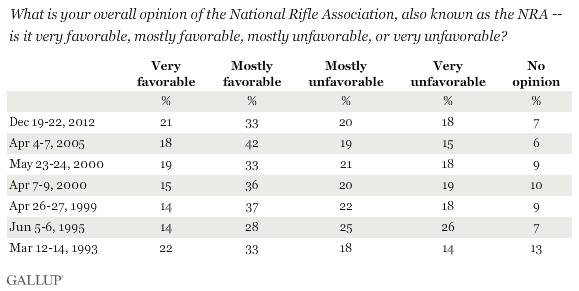PRINCETON, NJ -- Fifty-four percent of Americans have a favorable opinion of the National Rifle Association, while 38% have an unfavorable opinion. The public's ratings of the NRA have fluctuated since first measured by Gallup in 1993 -- from a low of 42% favorable in 1995 to a high of 60% in 2005.

The NRA's positions on guns and gun control legislation have received significant attention from media and politicians during the last week after the association's top lobbyist, Wayne LaPierre, held a press conference in the wake of the Newtown school shooting. LaPierre denounced the idea of additional gun control legislation and instead called for armed guards in the nation's schools. The press conference came midway through the field period of this Dec. 19-22 USA Today/Gallup poll.
On a more granular basis, 21% of Americans have a very favorable opinion of the NRA, and 18% have a very unfavorable opinion. These strong opinions have held roughly the same over the years, with the notable exception of 1995, when 26% reported a very unfavorable opinion of the NRA.

Most Gun Owners View NRA Favorably
Favorable opinions of the NRA are much higher than average among the 45% of Americans who report having a gun in the household -- although one in four view the NRA unfavorably. At the same time, four in 10 of those without a gun in the household have a favorable opinion of the NRA.
Republicans are more likely to own guns and are less in favor of gun control than are Democrats. These relationships no doubt contribute to the finding that more than eight in 10 Republicans have a favorable opinion of the NRA, contrasted with less than four in 10 Democrats. A slight majority of independents have a favorable opinion of the NRA. This same partisan pattern was evident the last time Gallup measured the image of the NRA in 2005.

Majority Say NRA Doesn't Always Reflect Their Views
A separate question included in the Dec. 19-22 survey asked Americans how often the NRA reflects their views about guns. Thirty-five percent say the NRA reflects their views always or most of the time -- more than said so the two previous times Gallup asked the question, in 1996 and 1999.
Sixty-one percent say that the NRA reflects their views only sometimes or never.

Although more than seven in 10 Americans with a gun in the household have a favorable opinion of the NRA, a significantly smaller percentage (50%) say the organization reflects their views on guns always or most of the time. On the other hand, 22% of those without a gun in the household say that the NRA reflects their views about guns always or most of the time.

Bottom Line
The National Rifle Association continues to have a majority favorable image in the eyes of the American public, as it has in all but one of the seven surveys in which Gallup has measured it since 1993. The NRA's image is highly politicized, with Republicans largely saying they have a favorable opinion, while a majority of Democrats view the association unfavorably. Most Americans with a gun in their household have a favorable opinion of the NRA, but one-fourth do not -- and 49% of those with a gun in the household say the NRA represents their views on guns only sometimes, or never.
Survey Methods
Results for this USA Today/Gallup poll are based on telephone interviews conducted Dec. 19-22, 2012, with a random sample of 1,038 adults, aged 18 and older, living in all 50 U.S. states and the District of Columbia.
For results based on the total sample of national adults, one can say with 95% confidence that the maximum margin of sampling error is ±4 percentage points.
Interviews are conducted with respondents on landline telephones and cellular phones, with interviews conducted in Spanish for respondents who are primarily Spanish-speaking. Each sample includes a minimum quota of 400 cellphone respondents and 600 landline respondents per 1,000 national adults, with additional minimum quotas among landline respondents by region. Landline telephone numbers are chosen at random among listed telephone numbers. Cellphone numbers are selected using random-digit-dial methods. Landline respondents are chosen at random within each household on the basis of which member had the most recent birthday.
Samples are weighted by gender, age, race, Hispanic ethnicity, education, region, adults in the household, population density, and phone status (cellphone only/landline only/both, cellphone mostly, and having an unlisted landline number). Demographic weighting targets are based on the March 2011 Current Population Survey figures for the aged 18 and older U.S. population. All reported margins of sampling error include the computed design effects for weighting.
In addition to sampling error, question wording and practical difficulties in conducting surveys can introduce error or bias into the findings of public opinion polls.
For more details on Gallup's polling methodology, visit https://www.gallup.com/.
